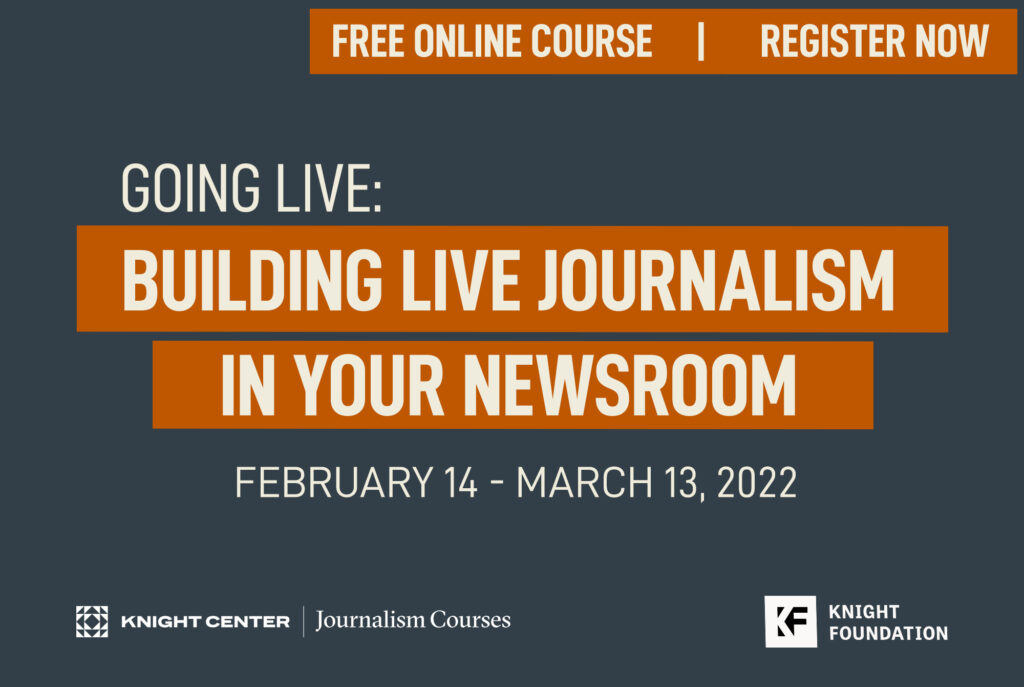
Journalists jumped from the paper to the stage, meeting hall and auditorium with the advent of live journalism. Now, especially with the COVID-19 pandemic, these live events have exploded in the virtual world.
Creating live journalism can be daunting for newsrooms without a dedicated team in place to take advantage of these new ways to tell stories and engage with audiences. A new course from the Knight Center for Journalism in Americas hopes to help in the process.
“Going live: Building live journalism in your newsroom” will teach how to build a live journalism franchise in your newsroom. The Massive Open Online Course (MOOC) runs from Feb. 14 to March 13, 2022. Click here to learn how to register today!
This free online course, sponsored by Knight Foundation, is taught by Kim Last, editor of Live Journalism and Special Content at The Wall Street Journal.
“We are grateful to Kim Last, one of the best experts in live journalism in the U.S., for agreeing to teach this important and timely course. And we are grateful to the Knight Foundation for its permanent support that allows us to offer free or low-cost training to thousands of journalists with our MOOCs,” said professor Rosental Alves, founder and director of the Knight Center at the University of Texas at Austin’s Moody College of Communication.
“Live journalism has been one of the most important trends in the news industry in the last years, a great opportunity for journalists to expand their job in new ways. And it can also become an opportunity for an additional revenue stream for news organizations, which is so needed in these times,” Alves said.
“If you work in a newsroom, technically live journalism has been happening all around you. Think about the dialogues you may overhear with a sharp reporter or editor—some of the best journalism takes place when you have a curious, prepared journalist asking smart questions and listening closely,” Last said. “Live journalism simply brings those same conversations, the same smart questions to a live audience.”
Live journalism expands your storytelling
“Live journalism is another platform to expand your storytelling and to shed light on a story beyond a given word count. I would urge newsrooms to explore and experiment in this medium because it can both generate news coverage or compliment coverage areas,” she added. “Live events are also one of the only concentrated places you can interact with your readers, well beyond the comments in a digital story.”
The pandemic emphasized the importance of live journalism events as screens became one of our main ways to connect with each other.
“With COVID-19, the pivot to virtual events has highlighted the accessibility of video,” Last said. “In a time where newsrooms are looking to deepen reader engagement, virtual events have democratized access and reach. The era of event content living and dying in a ballroom is in the past—virtual events allow for easy ways to translate event sessions for online audiences.”
During the course, students will complete four weekly modules, each focused on a distinct lesson.
The course will include video lectures from Last, readings and handouts/exercises, discussion forums and quizzes.
Instructor Kim Last is the top editor for live and virtual events organized by the newsroom at The Wall Street Journal. She joined the Journal about four years ago as deputy editor on the live journalism team, expanding the popular Future of Everything Series as its editorial director. Before that, she led conference development at Vox Media, working alongside the Recode and Vox.com teams. She was also senior editor at Fast Company, launching the inaugural Fast Company Innovation Festival.
This course is open to anyone, but is tailored to journalists, newsroom leaders and product managers who are interested in live events and aim to launch a live journalism project in their newsroom.
Like all Knight Center courses, this MOOC is asynchronous, meaning you can complete the course activities on the days and at the times that best fit your schedule. There are recommended deadlines so you don’t fall behind.
Students who successfully complete course requirements have the option of paying an administrative fee of U.S. $30 to receive a certificate of completion. The Knight Center will evaluate the cases of students who need a waiver of that fee. No formal college credit is associated with the certificate.
So, don’t miss the opportunity to participate in world-class training about an important trend in the news industry.